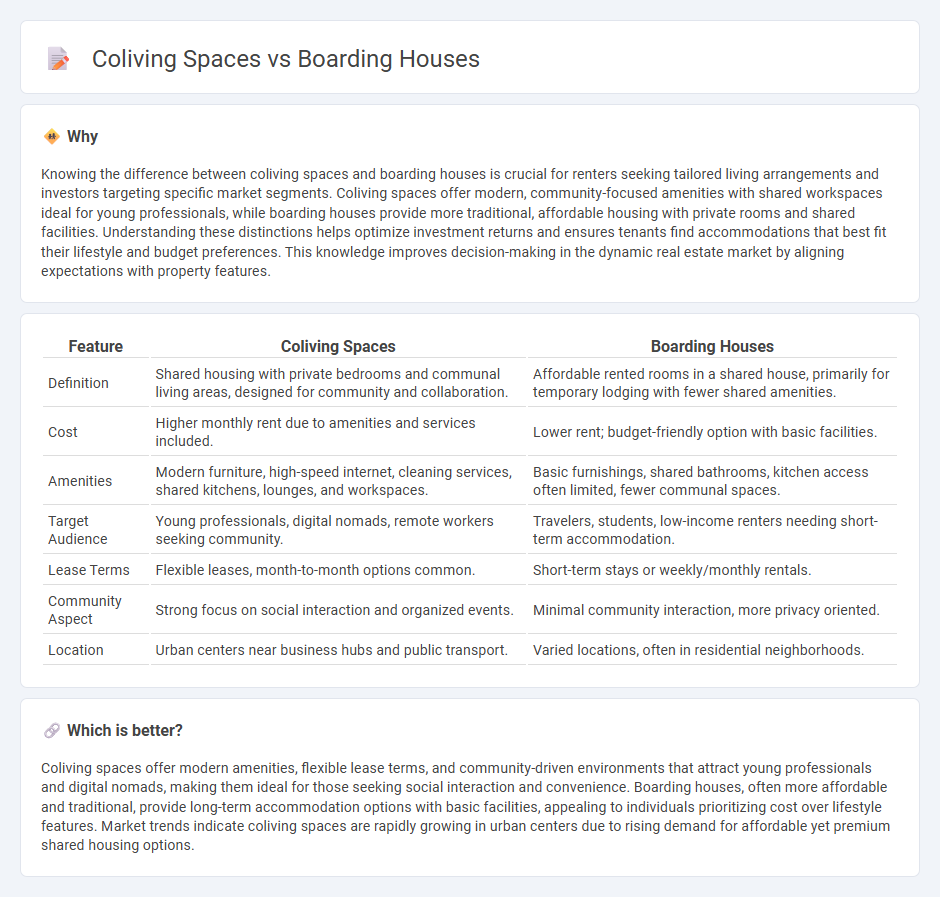
Coliving spaces offer modern, fully furnished accommodations with communal amenities designed to foster social interaction and flexibility, targeting young professionals and digital nomads. Boarding houses provide more traditional, affordable lodging often featuring private rooms and shared facilities, catering to long-term residents seeking budget-friendly housing. Discover the key differences to choose the best fit for your lifestyle and housing needs.
Why it is important
Knowing the difference between coliving spaces and boarding houses is crucial for renters seeking tailored living arrangements and investors targeting specific market segments. Coliving spaces offer modern, community-focused amenities with shared workspaces ideal for young professionals, while boarding houses provide more traditional, affordable housing with private rooms and shared facilities. Understanding these distinctions helps optimize investment returns and ensures tenants find accommodations that best fit their lifestyle and budget preferences. This knowledge improves decision-making in the dynamic real estate market by aligning expectations with property features.
Comparison Table
| Feature | Coliving Spaces | Boarding Houses |
|---|---|---|
| Definition | Shared housing with private bedrooms and communal living areas, designed for community and collaboration. | Affordable rented rooms in a shared house, primarily for temporary lodging with fewer shared amenities. |
| Cost | Higher monthly rent due to amenities and services included. | Lower rent; budget-friendly option with basic facilities. |
| Amenities | Modern furniture, high-speed internet, cleaning services, shared kitchens, lounges, and workspaces. | Basic furnishings, shared bathrooms, kitchen access often limited, fewer communal spaces. |
| Target Audience | Young professionals, digital nomads, remote workers seeking community. | Travelers, students, low-income renters needing short-term accommodation. |
| Lease Terms | Flexible leases, month-to-month options common. | Short-term stays or weekly/monthly rentals. |
| Community Aspect | Strong focus on social interaction and organized events. | Minimal community interaction, more privacy oriented. |
| Location | Urban centers near business hubs and public transport. | Varied locations, often in residential neighborhoods. |
Which is better?
Coliving spaces offer modern amenities, flexible lease terms, and community-driven environments that attract young professionals and digital nomads, making them ideal for those seeking social interaction and convenience. Boarding houses, often more affordable and traditional, provide long-term accommodation options with basic facilities, appealing to individuals prioritizing cost over lifestyle features. Market trends indicate coliving spaces are rapidly growing in urban centers due to rising demand for affordable yet premium shared housing options.
Connection
Coliving spaces and boarding houses both offer shared living accommodations that promote community and affordability within the real estate sector. They cater to urban dwellers seeking flexible lease terms and social interaction while minimizing housing costs. The growing demand for such communal housing models reflects shifting preferences towards convenience, accessibility, and collaborative lifestyles in densely populated cities.
Key Terms
Lease Agreement
Boarding houses typically feature individual lease agreements with shorter terms, often on a monthly basis, providing flexibility but limited communal rules. Coliving spaces usually offer longer, more structured lease agreements that include shared responsibilities, community guidelines, and amenities tailored to foster collaboration. Explore detailed differences in lease agreements to determine which living arrangement best suits your lifestyle and legal preferences.
Shared Amenities
Boarding houses typically offer basic shared amenities such as communal kitchens, laundry facilities, and common living areas, catering to budget-conscious tenants. Coliving spaces provide a more modern experience with enhanced shared amenities including high-speed internet, coworking spaces, fitness centers, and curated community events designed to foster social interaction and productivity. Explore the evolving landscape of shared living options to find the best fit for your lifestyle preferences.
Occupancy Regulations
Boarding houses typically face stringent occupancy regulations aimed at ensuring safety, health standards, and fire code compliance, often limiting tenant numbers per room based on local jurisdiction rules. Coliving spaces, designed for community living and shared amenities, benefit from more flexible occupancy guidelines that adapt to modern urban housing demands and encourage social interaction while maintaining legal housing standards. Explore detailed regulatory frameworks and practical implications to understand the evolving landscape of shared living environments.
Source and External Links
Boarding House - A boarding house is a type of accommodation where lodgers rent rooms, often with shared facilities and meal services, commonly found in family homes or dedicated buildings.
Is it time for America to bring back the boarding house? - This article discusses the potential revival of boarding houses as a solution for affordable housing in the U.S., highlighting their historical significance and communal benefits.
A History of Boarding Houses: Ideal Forms of Affordable Housing - This blog post explores the history and cultural impact of boarding houses, both in the U.S. and Europe, as a model for affordable housing and social integration.
 dowidth.com
dowidth.com